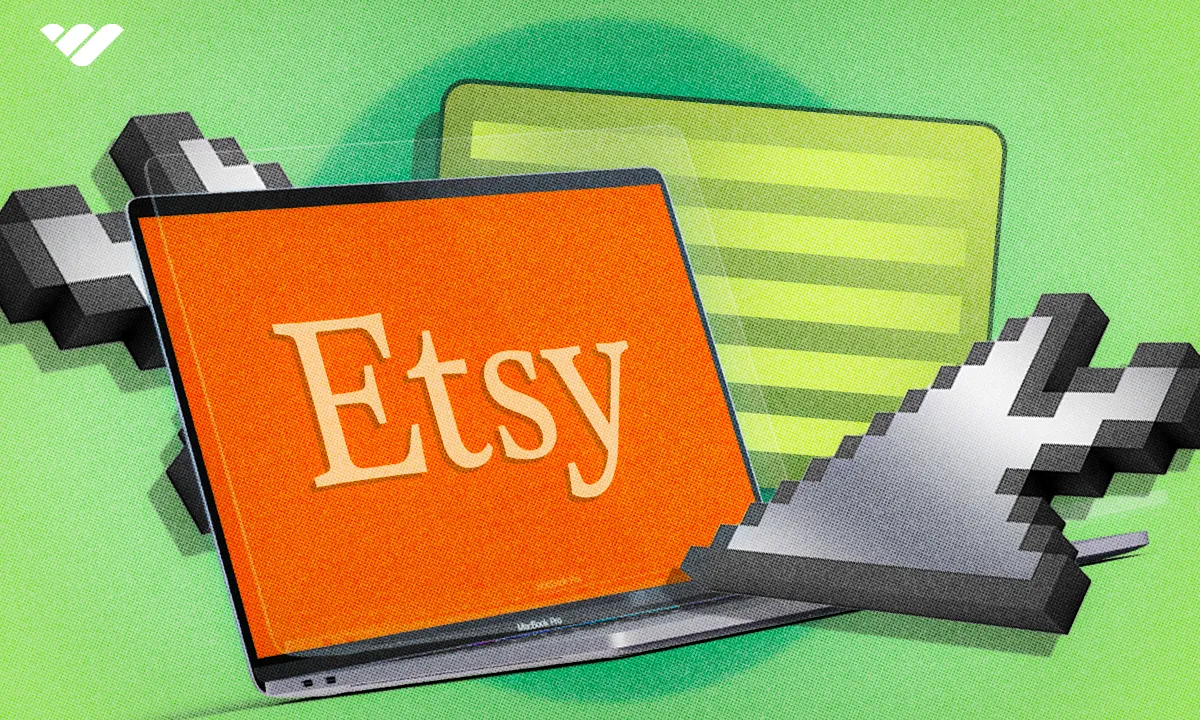Selling on Etsy is worth it if you're selling handmade or vintage items - digital product creators can find better platforms with lower fees.
Key takeaways
- Etsy works best for handmade and vintage sellers, but digital product creators may find better platforms due to low prices and high competition.
- Etsy fees total nearly 10% per sale, making it cheaper than Amazon but still significant for low-priced items.
- Success on Etsy requires optimized listings with strong keywords, quality images, and excellent customer service to stand out.
Etsy is worth it for handmade and vintage item sellers, but it can come short for people who want to sell digital products. Still, Etsy is a bustling marketplace perfect for creatives looking to start a remote side hustle.
So, what makes Etsy different from Amazon or eBay? Well, for one, it has a younger customer demographic. While Etsy has buyers of all ages, its largest group of users are aged 25 to 34.
On the other hand, eBay has most buyers in the 35 to 64-year-old camp. And, compared to Amazon, Etsy is much cheaper to set up. Their commission rates are lower per sale, and Etsy doesn’t charge monthly fees.
But those aren’t the only reasons the site is popular. Nearly 500 million people visit Etsy every single month, eager to support small businesses and sellers.
Why do people sell on Etsy?
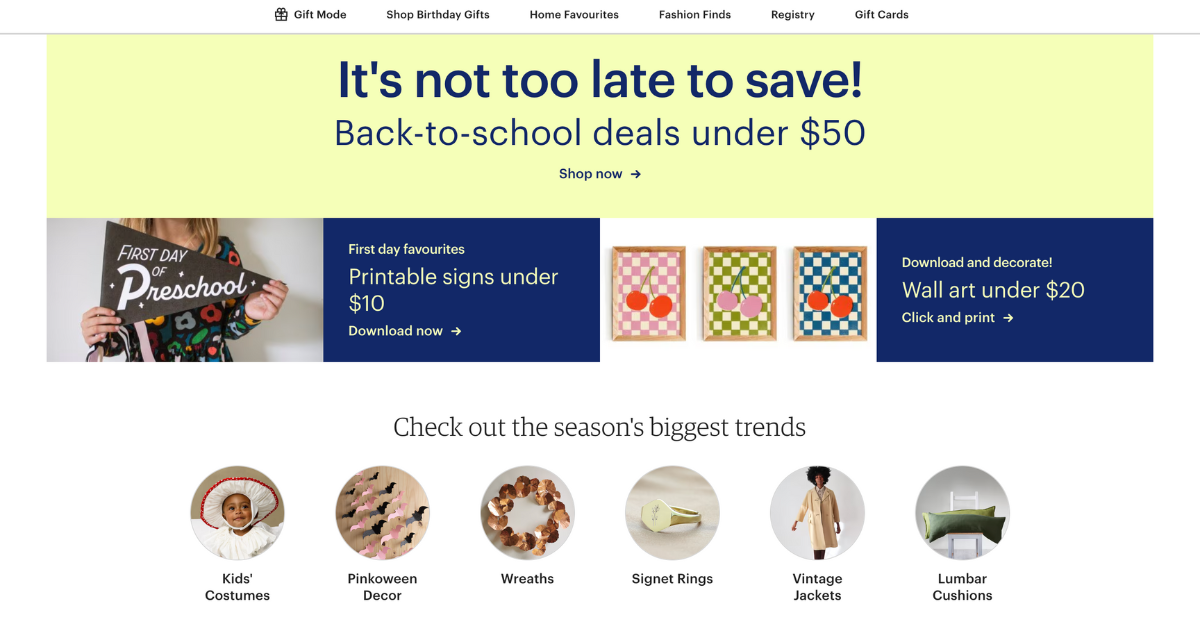
There’s a reason Etsy has seen such impressive growth in recent years (the number of active sellers grew by 21% in 2023 alone), and it has everything to do with the platform’s niche. Etsy built its popularity by prioritizing individuals, small businesses, crafters, and side hustlers.
In addition to increased sellers, Etsy’s customer base has grown to 91.5 million active buyers in the last decade. These buyers want to purchase anything from physical products like handmade ceramics and vintage jewelry to digital products like Canva templates and printables.
So, what can you sell on Etsy? Truthfully, most things. Browsing the Etsy categories, buyers can find anything from collectible coins to beeswax food wrappers to even more specialized items. While this demonstrates the diversity of sellers on the site, the most popular categories tend to feature more in-demand products.
What do people sell on Etsy? Etsy's top categories
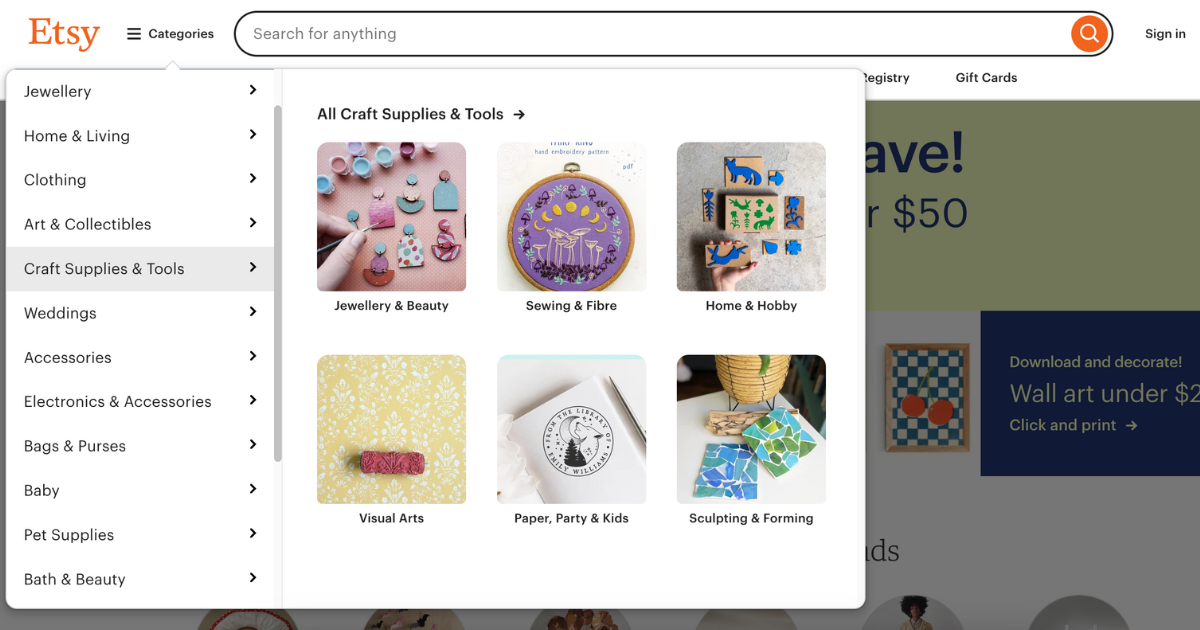
As we said, Etsy’s buyers often value supporting small, so the highest selling categories tend to be those in which handcrafters and creatives shine. Of these categories, the top are:
Accessories, bags & purses: Everything from handmade jewelry to custom handbags, glasses cases, silk ties, and more.
Art & collectibles: Original artwork and rare collectibles thrive on Etsy, appealing to collectors and art enthusiasts searching for unique finds.
Bath & beauty: Handmade soaps, skincare products, natural beauty items, small-batch makeup, and nail polish.
Books, films, & music: Indie ebooks, merchandise, royalty-free music, and unique film memorabilia are popular.
Clothing: Custom-printed t-shirts, tailored dresses, and vintage and retro clothing items.
Craft supplies & tools: Materials and tools for other crafters, such as specialty yarns, beads, and sewing patterns. Some of Etsy’s top sellers fall under this category.
Electronics & accessories: Handmade phone cases and unique tech accessories are popular, as well as phone lanyards, laptop covers, and electronic kitchen gadgets.
Home & living: Custom home decor, unique glassware, ceramics, towels, bedding, and cushion covers.
Jewelry: Handmade and custom jewelry, including rings, necklaces, and bracelets, are popular.
Paper & party supplies: Everything from wedding invitations and scrapbooking supplies to custom party decor.
Pet supplies: Unique and customized pet products, including clothing and accessories.
Shoes: Handmade or custom-designed, including unique, restored, and personalized footwear.
Toys & games: This includes handcrafted toys, educational games, and vintage finds.
Weddings: Bespoke bridal wear, unique party favors, bachelor and hen’s party items, and custom decorations.
Before we go any further, it’s worth noting that you don’t need to sell in one of these categories to make a good profit on Etsy. Selling in less popular categories might actually work to your advantage, reducing overall competition and increasing visibility. Let's take a look at the top sellers on Etsy.
Top 5 Etsy sellers
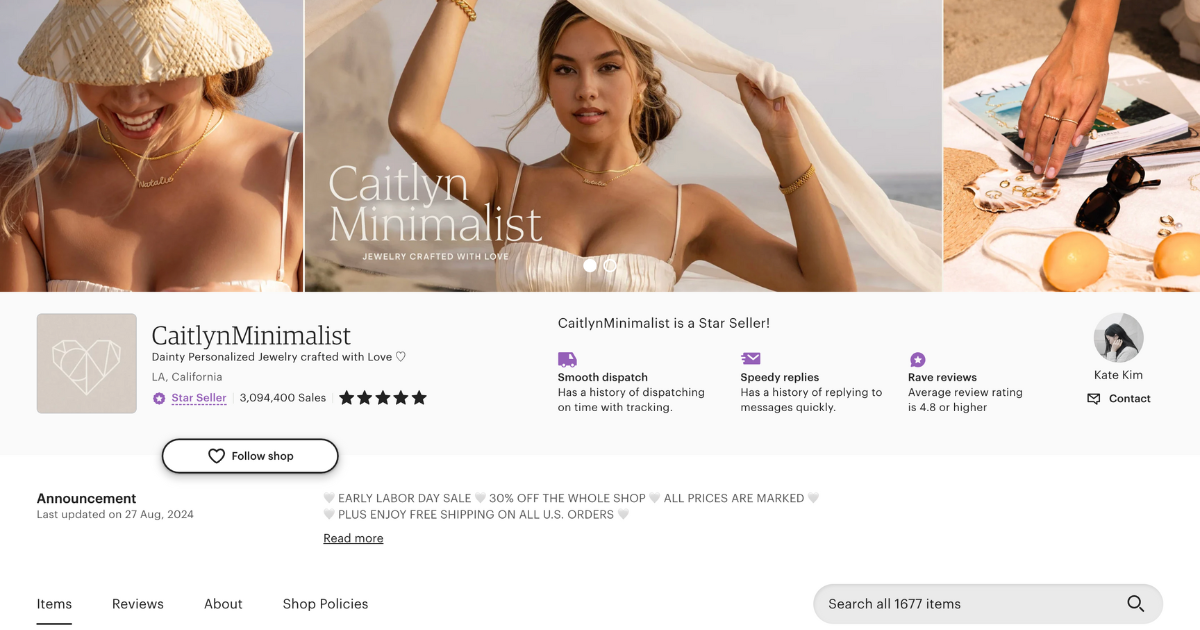
According to research from Alura, the top 5 sellers on Etsy are:
CaitlynMinimalist: With over 2 million sales, CaitlynMinimalist specializes in personalized jewelry and is known for her elegant and customizable pieces.
PlannerKate1: PlannerKate1 boasts 1.94 million+ sales and offers planners, stickers, and worksheets. Her products cater to those looking to enhance their planning and organization.
Beadboat1: With 1.78 million+ sales and a niche of craft items, Beadboat1 is a go-to store for crafters needing high-quality beads and supplies.
ModParty: ModParty’s customizable and unique party supplies are their niche, earning them 1.63 million+ sales.
Yakutum: With over 1 million sales, Yakatum provides extensive jewelry-making supplies to support amateur and professional jewelers.
As you can see, Etsy’s highest-earning sellers fall into different niches from the top categories list. However, they still share commonalities: clear listings, high-quality imagery and descriptions, well-thought-out and organized storefronts, and excellent customer service and feedback.
How difficult is it to sell on Etsy?
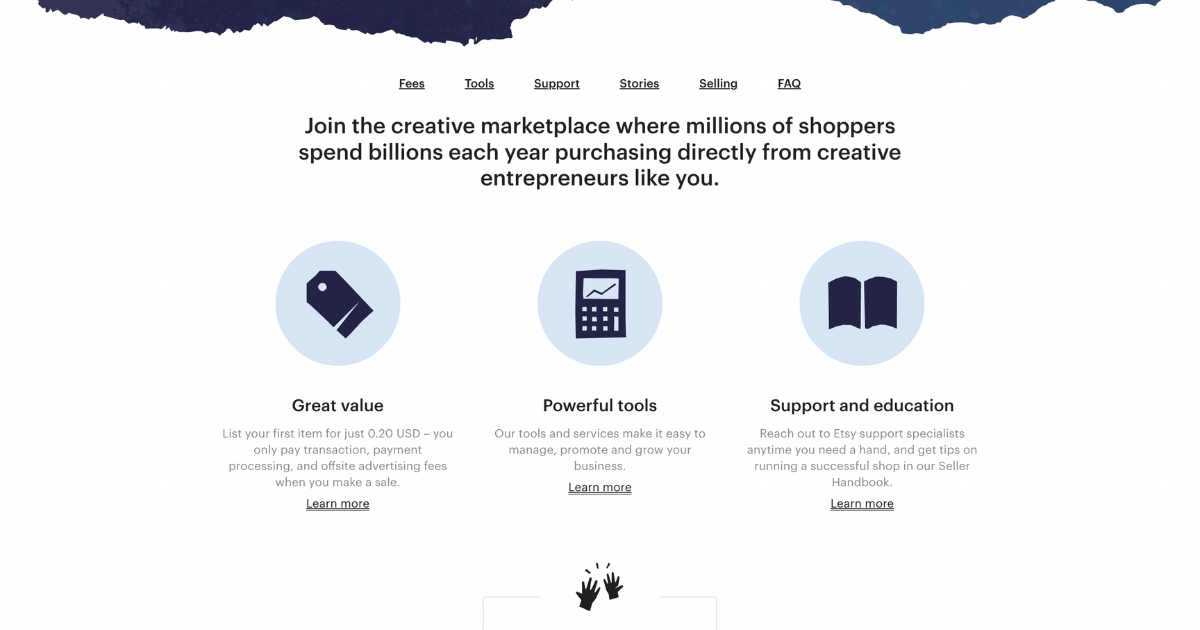
Setting up an Etsy account and storefront is easy. Making consistent sales, however, takes a little more work.
The reality of selling on the platform is that the competition can be fierce. That shouldn’t deter you from getting started, though. By developing a marketing strategy that incorporates key methods to promote your Etsy store, you can cut through the noise of competitors and reach your target demographic.
A couple of key things to note? Titles, keywords, and tags are paramount. They improve your search rankings and help you get seen by your target customers. Another thing to be mindful of is your listing quality–i.e., having clear images, properly categorizing, and writing detailed descriptions.
Focussing on these aspects of your storefront (as well as the basics of good customer service) is key to pleasing the Etsy algorithm and making money.
What are Etsy's fees?
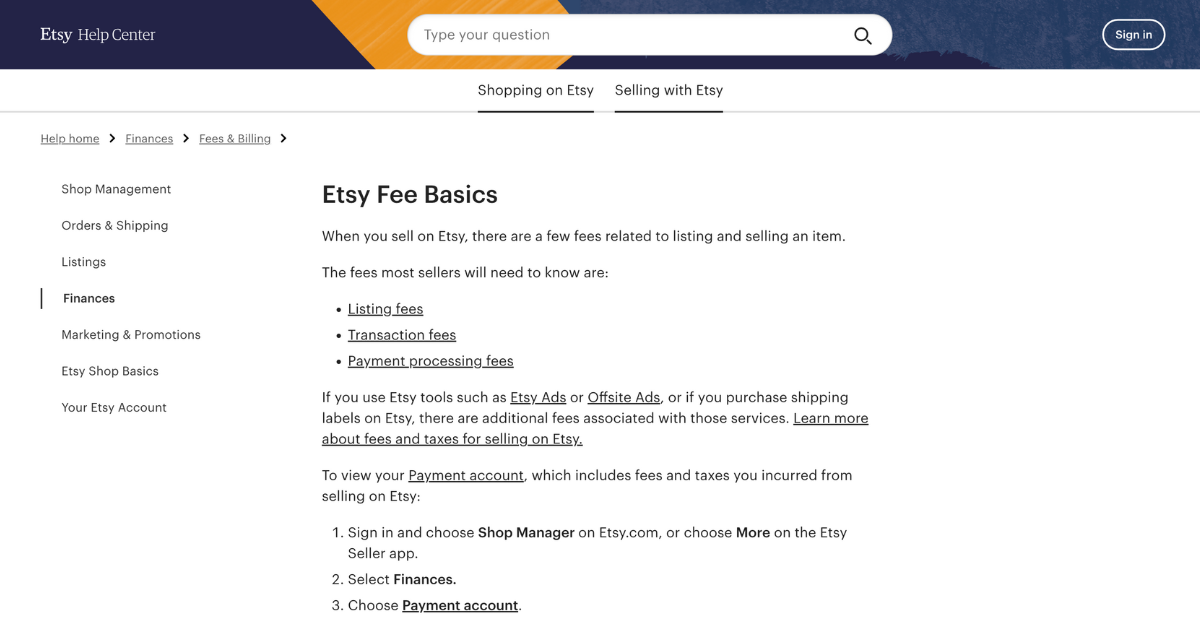
Selling on Etsy has many advantages, from ease of use to its niche in the market. However, the most important factor for most sellers is the cost associated with setting up a store and making each sale.
Many different fees are associated with running a successful Etsy store. While some are optional, such as the ability to run ads or upgrade your account, most are not. Here’s an overall breakdown of the costs of running an Etsy store. Note that some of these costs depend on factors such as location and sales tax.
Setup fee
A $15 one-off fee is charged for setting up your store.
Listing fee
$0.20 charged for each product listing. Your listing stays live for up to four months or until sold. If you opt for auto-renewal, you’ll be charged an additional $0.20 every four months.
Multi-quantity listing fee
If a customer buys multiple items from a single listing, you'll pay an extra $0.20 for each additional unit beyond the first (ouch).
Transaction fee
This one’s the kicker. Etsy takes 6.5% of the total sale price, including shipping and gift wrapping, as a commission.
Payment-processing fee
This fee is for processing payments through Etsy Payments. It’s a flat rate plus a percentage of the sale. It’s 3% of the total sale for U.S. sellers plus $0.25. For worldwide payment-processing fees, head to Etsy's fee page.
FYI: Combining the transaction and payment-processing fees can total nearly 10% of your sale.
Location-based fees
VAT is applicable if you sell to customers in the EU or the UK. VAT rates vary by country; details can be found on the Etsy help center.
Sales tax
Etsy collects sales tax in most U.S. territories, which is added to transaction costs. You can opt to handle this yourself or let Etsy manage it.
Regulatory operating fee
Some countries charge an additional fee for digital transactions:
UK: 0.25%
France: 0.40%
Italy: 0.25%
Spain: 0.40%
Turkey: 1.1%
The best (and worst) niches for Etsy sellers
For most crafters and resellers, Etsy is a worthwhile marketplace. Getting set up is relatively easy, and listing products requires little know-how. As mentioned earlier, Etsy has smaller commissions per sale than other marketplaces, which appeals to sellers just starting out.
However, is selling on Etsy worth it for you?
The answer to that really depends on what you’re selling. Again, Etsy focuses on unique, handmade, and crafted goods. And while that doesn’t mean you can’t have success selling outside of these niches, there could be marketplaces better suited to you, your products, and your business goals.
Selling handmade goods on Etsy
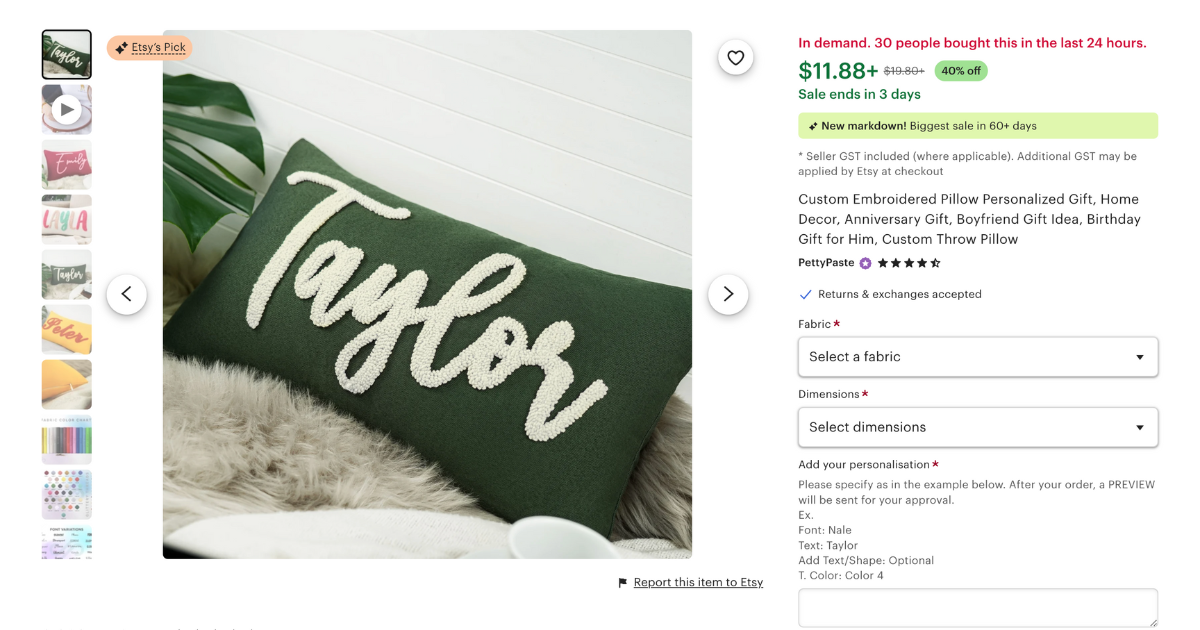
Etsy is an ideal platform to sell your goods if you're a craftsperson or artisan. Because of Etsy’s emphasis on originality and personal touches, handmade goods (custom jewelry, hand-knitted scarves, bespoke furniture, etc.) will likely find a receptive audience. Many handmade sellers on Etsy have turned their passions into full-time businesses.
Again, though, competition is stiff. Keep in mind what we mentioned earlier about keywords, descriptions, and listing quality–so that you can please the Etsy algorithm and maximize your searchability. Building a strong brand presence, engaging with your customers through social media, and swiftly fulfilling orders will help you stand out.
Selling vintage clothing on Etsy
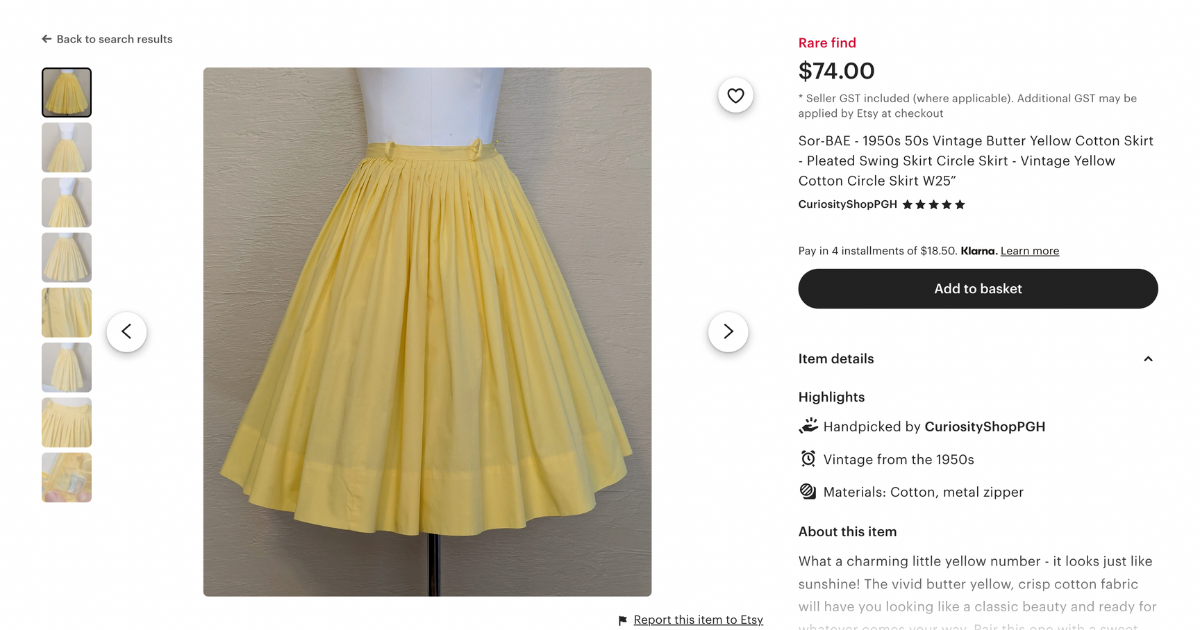
Vintage clothing (and accessories, bags, jewelry, etc.) also sell well on Etsy, as the platform has a strong community of secondhand lovers. Vintage clothing is a hot commodity right now–did you know the online resale market for clothing is projected to grow to $64 billion this year?
Whether a '70s leather jacket or a '90s graphic tee, ensure your items are in good condition. When it comes to your listings, accurately describe the garments’ history and sizing. Photos are crucial for clothing; they help buyers appreciate the finer details and overall condition of the items. Vintage sellers often benefit from a well-defined niche, so consider specializing in a particular era or style to attract dedicated fashion aficionados and boost your shop’s visibility.
Selling digital products on Etsy
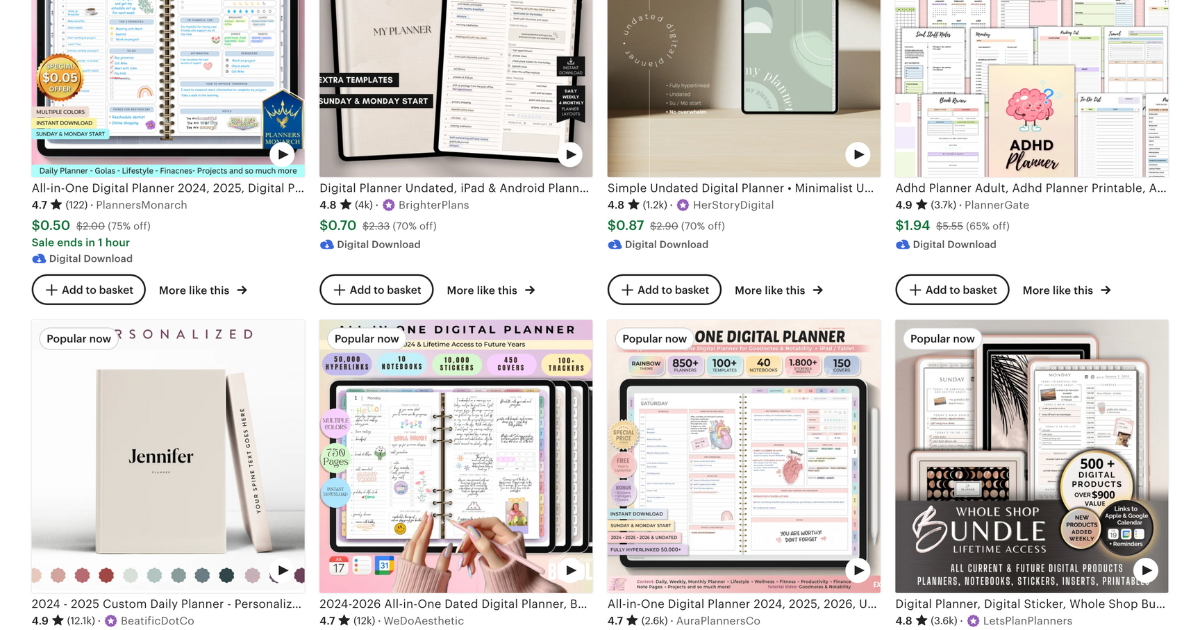
Selling digital products on Etsy—printables, templates, downloads, etc.—is also an option.
Digital products have the advantage of no shipping costs or physical inventory, so they’re a relatively easy, scalable option for sellers. However, the market can be even more competitive–digital products are yet to break into Etsy’s top categories, so there is less of a market for them than other products for sale. Plus, digital products are usually low-priced on Etsy (just check out some of the prices in that image above), and the fees take a big chunk of this. So while your digital product may be popular, it may not be profitable.
If you do want to sell digital products with Etsy, then create high-quality, well-designed products. Utilize the image section of your listing to offer clear, attractive previews so people can get a taste of what they’re paying for.
While Etsy is an option for those selling downloadables, exploring platforms that are specifically designed for digital sales, like Whop, can offer even more benefits.
Selling on Etsy: The pros and cons
Whether you should become an Etsy seller isn’t a black-or-white answer. It’s likely to depend on many factors, such as your products, business plan, budget, target demographic, and more.
While we can’t advise you on whether Etsy is the right platform for you, we can help you weigh its benefits and any potential drawbacks to make a more informed decision.
With that being said, here are the main things you’ll want to consider before selling on Etsy:
| Pro: | Con: |
|---|---|
| Setting up your Etsy shop is straightforward; Etsy even provides a step-by-step guide. You can start listing products within a few hours. | With a growing number of sellers, standing out on Etsy can be challenging. Many sellers need to invest in marketing and ads. |
| Etsy has built-in tools to help you promote your listings through ads, social media integration, and SEO tips. | While Etsy has a strong user base, it's still smaller than giants like Amazon. |
| Etsy's fees are generally lower than those of Amazon and eBay, which can be appealing to new sellers. | In addition to listing and transaction fees, Etsy's additional costs, like shipping and promotional expenses, can be heavy. |
| Dedicated and supportive customer base. | Limited options for store personalization. |
| Strong niche for handmade and crafted goods. | Less of an engaged market for digital products and downloadables. |
The verdict: Is selling on Etsy really worth it?
We’ve discovered that Etsy stands out for certain niches–but it isn’t ideal for all sellers.
Etsy certainly excels as a marketplace for handmade, artisanal, and unique items. For these sellers, having a hot audience of consumers already searching for one-of-a-kind goods is a huge plus. Because the platform has lower listing fees than other major ecommerce sites, it's a good contender for artisans and small business owners looking to showcase handmade creations.
For resellers, while Etsy does accommodate vintage items, it’s worth noting that there are platforms specifically tailored to this market. Sites like Mercari and Poshmark were built to sell vintage and secondhand clothing, and they offer user features that are likely to better align with your business goals. Using specialized marketplaces provides more targeted exposure, potentially leading to higher sales.
Speaking of specialized marketplaces–Etsy might not be the best fit if you're selling digital products. While some sellers (like the aforementioned Amma Rose Designs) can make big bucks on Etsy, this isn’t all that common. Selling ebooks, downloadables, templates, or online courses on the platform can be challenging due to costs, visibility, and storefront limitations.
That’s where Whop comes in.
Sell your digital products with Whop and keep more money in your pocket
At Whop, we offer a sales platform built purely for selling digital products and give our sellers extensive community-building and marketing tools with their membership.
You can sell almost any kind of digital product on Whop - from downloadable PDFs, to online courses, ebooks, and even paid community access. Plus, you can bundle products, offer multiple payment methods, and even host a community in your own whop.
There are no monthly or signup costs, just a 2.7% + $0.30 fee on each sale. It’s so easy to start; you can build a Whop storefront and sell digital products within minutes.


